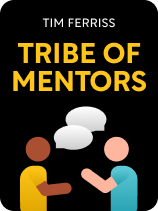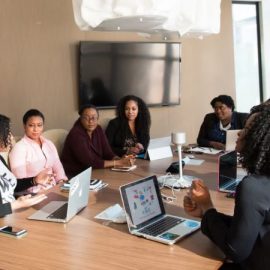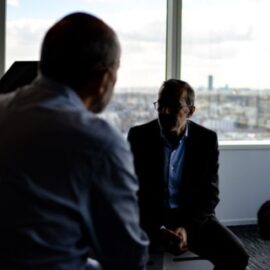

This article is an excerpt from the Shortform book guide to "Tribe of Mentors" by Tim Ferriss. Shortform has the world's best summaries and analyses of books you should be reading.
Like this article? Sign up for a free trial here.
Where do you go for advice? What if you had a tribe of mentors to consult about your life and career?
In Tribe of Mentors, Tim Ferriss distills advice from more than 130 world-class experts such as actor Ben Stiller, entrepreneur Gary Vaynerchuk, and media mogul Ariana Huffington. Ferriss reached out to these experts and compiled their advice when he was seeking direction in his own life.
Continue reading for an overview of this book that can help you, too, find direction.
Overview of Tim Ferriss’s Tribe of Mentors
If you want to know how to live your life, who better to ask than people who have lived life to its fullest? In Tribe of Mentors, Tim Ferriss compiles life advice from experts of all kinds, including artists, athletes, and entrepreneurs.
Author Tim Ferriss got the idea to write Tribe of Mentors around the time he turned 40. Facing a mild existential crisis, uncertain about how he wanted to live going forward, he decided to solicit advice from the wisest, most successful people he could think of. Ferriss sent the same list of 11 questions to these experts via email and Twitter, promising to put his favorite responses into a book.
This book is a spiritual successor to Ferriss’s book Tools of Titans, another collection of distilled wisdom. Ferriss asserts that Tribe of Mentors covers a broader range of perspectives than Tools of Titans.
We’ve categorized the book’s advice into broad topics, emphasizing ideas repeated by multiple experts:
- How to Take Advice
- How to Spend Your Time Well
- How to Build a Fulfilling Career
- How to Fail Well
- How to Say No
- How to Recenter Yourself
- How to Be Kind to Yourself
How to Take Advice
First, let’s discuss a topic that may influence how you read the rest of this: how to interpret and apply advice. We’ll begin by explaining why you shouldn’t completely trust any piece of advice, no matter who gives it to you. Then, we’ll detail an alternative: trusting your intuition more than the authority of others.
Don’t Fully Trust Any Advice
Some of Ferriss’s experts argue against blindly accepting any advice because no single piece of advice applies to everyone. Writer and speaker Julia Galef asserts that the exact same advice may be helpful to one person and unproductive to another who’s in a different situation. Learn to critically judge the advice you receive, tailoring it to your unique circumstances or rejecting it if it doesn’t apply to your situation.
Similarly, philanthropist John Arnold recommends largely ignoring the advice of others. He says that nearly everyone who gives advice is drawing solely from anecdotal experience. Consequently, they make statements that seem objective but are actually unique to their circumstances. There’s no single path to greatness, no matter what anyone says. Two people using vastly different strategies can both find wild success. For instance, one author may write a bestseller by forcing themselves to sit and write down every idea they have. Another may write their bestseller by taking frequent walks and only writing down ideas when they flow naturally.
Trust Your Intuition
Rather than trusting the expertise of others, some of Ferriss’s experts suggest learning to take advice from yourself—trusting your intuition.
Hedge fund advisor and chess master Adam Robinson asserts that the intuitive unconscious mind is significantly more powerful and insightful than the conscious mind. Filmmaker and author Soman Chainani elaborates, arguing that many of your conscious thoughts that seem true are actually false ideas from your past that you haven’t challenged. In contrast, your unconscious mind communicates with intuitive feelings and images that are often more accurate indicators of the truth.
Trust Your Intuition When Creating Art
Many of Ferriss’s experts assert that trusting your intuition is particularly important when you’re creating art. Actor and director Ben Stiller argues that a unique, authentic voice is what makes art compelling. In particular, he warns against overriding your intuition by modeling your art after what you assume a broad audience wants to see. Television showrunner Brian Koppelman agrees, adding that the only way you can fully dedicate your heart and soul to your work is to create what you intuitively feel drawn to create. He notes that this level of dedication is necessary for the highest creative success.
How to Spend Your Time Well
Now that we’ve discussed how to interpret and apply advice, let’s examine some of Ferriss’s experts’ advice on the broad topic of purpose: What should you do with your life? More specifically, how should you spend your time?
To answer these questions, we’ll first explain why it’s necessary to identify what matters most to you and prioritize meaningful causes over other ways you could use your time. Then, we’ll discuss why it’s best to work as hard as you can in pursuit of these meaningful goals (while resting enough to do so effectively).
Identify What’s Most Important to You
Many of Ferriss’s experts argue that assessing what you truly care about is the key to spending your time in a fulfilling way. Rabbi Jonathan Sacks asserts that, once you dedicate yourself to a noble life purpose that’s greater than yourself, you’ll feel fulfilled no matter what painful obstacles are in your way.
How do you identify what’s most important to you? Pinterest founder Ben Silbermann recommends journaling to clarify your values. Take a break from your urgent daily tasks to reflect on what matters—write down what’s most important for you to do in the next few days, the next few months, and especially in the next several years. People feel lost and confused when they lose sight of their long-term intentions.
On the other hand, author Steven Pressfield (The War of Art) contends that discovering what’s most important to you isn’t this simple. He frames the search for personal values as an ongoing struggle, arguing that you can only learn who you are and what you care about naturally through life experience—in particular, through experimentation and failure.
Actively Prioritize What’s Important
After you’ve identified what’s most important to you, you can find fulfillment by spending time on that meaningful purpose. However, historian Sarah Elizabeth Lewis asserts that life is full of distractions keeping you from pursuing what matters most to you. To overcome this, Lewis recommends blocking out time every day to make progress on your most important goal. Dropbox founder Drew Houston agrees, offering the more extreme recommendation to track your time in detail and reflect objectively on how you spend each hour of the day. Then, proactively build large blocks of time into your schedule to accomplish important tasks.
Financial blogger Pete Adeney argues that the biggest prioritization mistake people make is sacrificing their time and energy to earn money for things they don’t truly want or need. Adeney retired at age 30 with enough money to support himself and his family for the rest of his life on a frugal but comfortable budget. Accomplishing this involved rejecting anything that he didn’t value and saving up for what he really wanted: freedom from the obligation to work.
Work Hard to Achieve Important Goals
Many of Ferriss’s experts advocate working as hard as you can to accomplish the important goals you’ve identified and prioritized. Weightlifting champion Jerzy Gregorek argues that everything that makes a meaningful impact on the world is the result of countless years of hard work. Thus, working hard is the ultimate act of love and selflessness you can give. Whenever you face a challenging decision, ask yourself which choice involves more hardship—it’s usually the right one.
Hard Work Is Rewarding
Additionally, some of Ferriss’s experts contend that hard work is its own reward. Champion wrestler and quadruple amputee Kyle Maynard asserts that painful struggle is the source of his greatest joys. He states that he gets much more fulfillment from fighting against impossible odds than he would from settling into a safe, comfortable life.
How to Build a Fulfilling Career
Now that we’ve covered why it’s important to spend as much time as possible on the goals you care about most, let’s apply these ideas to professional work—how do you build a career that you’re happy to spend time on?
In this section, we’ll discuss whether or not passion for the work should be your highest priority when searching for a job. Then, we’ll explore how some experts advise rejecting the traditional path to success and embracing a more risky lifestyle.
Follow Your Passion
Many of Ferriss’s experts agree that a job you’re excited about is the core of a fulfilling life. Political commentator Tommy Vietor argues that true passion should be your number one priority when looking for a career. Record producer Rick Rubin notes that if you follow your passion, you won’t care whether you find success or not since you’ll be doing something you love.
Design expert Debbie Millman takes this idea further, arguing that if you’re truly pursuing your passion, you’ll have no reason to worry about maintaining a work-life balance. The work itself will feel like all you need in life. Fantasy author Neil Gaiman voices a similar opinion, stating that work is there to center his life and make him feel content when nothing else will.
Don’t Follow the Traditional Path to Success
Many people follow the traditional path to success—slowly ascending from one secure job to a slightly better-paying one. However, some of Ferriss’s experts note that constricting yourself to this path may keep you from building a career you’re passionate about.
Actress Richa Chadha notes that the education system typically sets everyone up to follow the same path to success, but this comfortable, low-risk life can be a trap for people with bigger ambitions. If you want to leave a field you’re not excited about, throw yourself into a new pursuit completely; otherwise, it’ll be too tempting to go back to that comfortable life.
Actor and comedian Patton Oswalt describes one way to commit to an untraditional life path: Get used to poor, cheap living conditions so you don’t have anything to lose and the risks necessary for an untraditional career don’t scare you away. Entrepreneur Jérôme Jarre took this idea to the extreme, secretly living out of an office building in New York City for several months until his startup began earning profits.
Cryptocurrency pioneer Nick Szabo also advocates for non-traditional career paths, noting that you shouldn’t feel the need to jump constantly from job to job. Unemployment can give you the space and freedom to devote your full attention to the creative ideas that seem the most promising to you.
How to Fail Well
If you choose to pursue work you’re passionate about, you’re likely to experience some failure along the way. What’s the best way to handle these failures? Ferriss’s experts explain that, to push through failure, you just need to focus on the following upsides:
- Upside #1: Failure Teaches You
- Upside #2: Failure Pushes You to Get Creative
- Upside #3: Failure Gives You Freedom
Let’s discuss each of these upsides in more detail.
Upside #1: Failure Teaches You
Physician Gabor Maté (When the Body Says No) asserts that failure shows you how to improve yourself. Being fired from his job as a medical coordinator helped him discover that he was far more self-absorbed and less personable than he had realized. This prompted him to improve himself and find success in his next job. Similarly, CrossFit athlete Mathew Fraser lost a championship that he was certain he would dominate, which taught him he was prideful and complacent. This motivated him to work harder, allowing him to win the championship the next year.
Upside #2: Failure Pushes You to Get Creative
Some of Ferriss’s experts assert that failure is valuable because it forces you to respond in creative ways. These creative solutions often yield unique results since other people likely haven’t tried them before. Bodybuilder and acrobat Jon Call recounts how a severe ankle sprain caused him to train in ways that didn’t rely on his legs—specifically, using gymnastic rings. This gave him unique experience and pushed his skills in new directions he otherwise wouldn’t have chosen.
Similarly, burlesque performer and entrepreneur Dita Von Teese describes how her failure to become a ballerina forced her to forge an alternate path to the lifestyle she wanted. She had to think of a way into the elegant side of show business that didn’t require memorizing and executing intricate choreography—a limitation that inspired her to start performing burlesque. Von Teese contends that this adaptation made her unique and allowed her to have a greater impact on the world.
Upside #3: Failure Gives You Freedom
Comedian and actor Patton Oswalt argues that devastating failure is valuable because it gives you freedom from fear. After you fail, time passes and you realize that almost no failure has major permanent consequences. This reveals that there’s nothing to be afraid of, giving you the courage to risk failure again and improve your skills.
Additionally, filmmaker David Lynch contends that failure gives you freedom from all creative constraints. After a massive failure, you have nothing more to lose, allowing you to create whatever your heart desires. This creative freedom is a source of pure joy.
How to Say No
As you build a fulfilling career, learn from failure, and attain valuable skills, people will likely begin to put more demands on your time. Many of Ferriss’s experts agree that if you want to devote your life to the priorities you care about the most, you have to aggressively defend your time against these requests.
Actress Aisha Tyler acknowledges that it’s difficult to deny people asking you for help; however, every distraction you allow into your life takes you further from your meaningful goals. Chef Samin Nosrat agrees, adding that the clearer your personal goals are in your mind, the easier you’ll find it to deny people making requests.
How to Recenter Yourself
Sometimes, even after you’ve identified what matters most to you and are happily pursuing it, you’ll feel too tired or scattered to focus and do the work. Ferriss’s experts offer a few options for putting yourself back into a positive, productive mindset:
- Option #1: Take a Break
- Option #2: Engage the Body
- Option #3: Meditate
- Option #4: Shift Your Perspective
Option #1: Take a Break
Filmmaker Darren Aronofsky contends that you should never feel guilty about taking a break from work when you need it. When you’re having an off day and feel stuck, just go do something else—anything that allows your mind to wander and rest. Even if you’re not thinking about the problem, you’ll be unconsciously working through it in the back of your mind.
Similarly to Aronofsky, author and former skier Kristen Ulmer argues that when your body and mind start to resist the work, the best course of action is to stop working and listen to them. Do nothing but live in the moment, allowing yourself to get distracted and paying attention to how it feels. After living mindfully for long enough, your motivation to tackle the work will return—whether it takes a few minutes or a few days.
Option #2: Engage Your Body
Many of Ferriss’s experts note that any activity that gets you out of your mind and into your body is an effective way to recenter yourself. Entrepreneur and author Marie Forleo (Everything Is Figureoutable) states that strenuous physical exercise allows you to thoroughly clear your mind and access a deep, unconscious intelligence in the body that helps you solve problems. Martial artist and chess master Josh Waitzkin (The Art of Learning) also advocates exercise as a mental tool, contending that engaging the body fundamentally changes how your mind runs.
Option #3: Meditate
Many of Ferriss’s experts advocate for routine meditation as a productivity tool. Musician Mike D (of the Beastie Boys) finds that a short meditation session gives him renewed focus for hours. Similarly, DJ Steve Aoki uses meditation to clear his mind and prepare to enter the flow state at work: an egoless, focused, creative state of mind conducive to maximum productivity.
Option #4: Shift Your Perspective
If you’re in an unproductive emotional state, some of Ferriss’s experts recommend using thought experiments to get yourself thinking in new terms.
Thought Experiment #1: Detaching From a Situation
To let go of a painful emotion caused by an upsetting situation, actress Richa Chadha recommends repeatedly asking yourself “So what?” in response to what happened, and to continue asking “So what?” until you’ve gained enough of a distant, big-picture perspective to no longer feel so upset. For example, if a coworker takes credit for your project at work, you might ask “So what?” and respond that “Our boss is going to think better of them than they deserve.” Ask again: So what? “They might get a bigger bonus than me.” So what? “I guess money isn’t very important.” Eventually, you reach a view of the situation that seems less threatening.
Thought Experiment #2: Creating Gratitude
To cultivate gratitude and motivate yourself to live in the present moment, computer scientist Muneeb Ali suggests a thought experiment: Imagine the future in which you’re old, nearing death. Ask yourself how much you’d be willing to spend on a time machine that lets you relive this moment. This ideally will help you slow down and enjoy the priceless moments that you’d otherwise ruin by worrying about the past or future.
How to Be Kind to Yourself
While you may feel pressured to follow all this advice to the letter, many of Ferriss’s experts acknowledge that this is an extremely difficult task. Be kind to yourself and don’t feel the need to try too hard, these experts advise.
Activist and businesswoman Muna AbuSulayman asserts that it’s easy to feel like you have to be perfect and achieve wild success in every area of your life every day. However, this unrealistic expectation will cause you to suffer. Instead, try your best, then quit worrying. This peaceful acceptance of any outcome helps you enjoy life and ensures that instead of getting discouraged and quitting if things don’t go to plan, you’ll be happy to try your best again next time.
Filmmaker Robert Rodriguez argues that it’s possible to maintain a playful mindset even in the most stressful situations. When Rodriguez faces tasks that seem impossible to accomplish with the time and resources he has, he makes it a habit to loudly proclaim, “Fácil!”—Spanish for “easy”—to everyone around him. This mantra is half-joking and half-serious. It helps Rodriguez and his collaborators maintain a sense of humor as they work and gives them the optimism they need to accomplish much more than they thought was possible.
Exercise: Apply the Mentors’ Advice
Since the advice in Tribe of Mentors is so wide-ranging, something in the book is likely relevant to your life situation. Complete and repeat this exercise whenever you need to translate some of the wisdom from this book into productive action.
- Which piece of advice from Tribe of Mentors feels the most useful for your current life situation, and why? (For example, perhaps Drew Houston’s advice to track how you spend your time resonated with you because you can’t seem to find the time to make progress on the side business you want to start.)
- Use that piece of advice to identify one small task you could do to improve your life. Make this task something that takes 15 minutes or less to make it easy to motivate yourself to do it. (For example, perhaps you want to make a daily log of how you spend each hour. That way, you can identify places where you can replace meaningless actions, like scrolling social media, with ones that help you progress your side business.)
- Make a plan to turn this task into a habit. How often would you ideally want to repeat this task? How could you motivate yourself to stick with it? (For example, perhaps you want to review your previous day’s schedule for 15 minutes every single morning. To get yourself to stick with it, you set your morning alarm 15 minutes earlier and reward yourself by listening to your favorite song every time you do it.)

———End of Preview———
Like what you just read? Read the rest of the world's best book summary and analysis of Tim Ferriss's "Tribe of Mentors" at Shortform.
Here's what you'll find in our full Tribe of Mentors summary:
- Distilled life advice from over 130 world-class experts in various fields
- How to navigate non-traditional career paths, appreciate failure, and more
- Why you should allow a small amount of measured chaos in your schedule






